
In this cloud computing basics pdf review, you will learn the fundamentals of cloud computing. When you’re done reading this review, don’t forget to leave your comments or questions in the box below and subscribe to this blog for more updates.
The following video is a summary of what you will learn about cloud computing in this book.
1. What is Cloud Computing?
1.1. What We Cover and What We Avoid in Our Cloud Computing Basics PDF
If you’ve read anything about the cloud or cloud computing, there is a phrase you may have already encountered. It’s a few words some people use to describe the cloud. If you haven’t seen this phrase yet, you’ll probably see it soon. You might see it on a laptop sticker, a tee shirt, or a coffee mug. It says:
“There is no cloud. It’s just someone else’s computer.”
It’s become quite popular. You can find dozens of products with this saying on it.
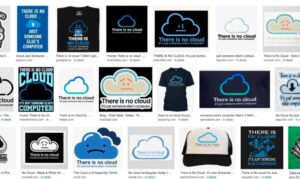
This phrase is short and memorable, and there is an element of truth to it. But there’s also a problem. It completely misses the point. It puts our attention on the wrong thing. Let’s be honest, this isn’t an objective and neutral definition. It’s a bit of an insult. It’s a little dig and dismissive.
“Hmmm… the cloud. What’s the big deal? It’s just someone else’s computer.”
Now to be clear, my issue is not that I need everyone to be polite and respectful about it. If you want to poke fun at any technology, be my guest. And if you’re coming into this with some criticisms, doubts or just feeling completely unsure about all this cloud stuff, that’s perfectly fine. What I’m going to suggest is that an oversimplification like this one just isn’t useful here.
It doesn’t help because this can encourage you to trivialize and underestimate how important the cloud already is and definitely how important it’s becoming. There’s a recent Gartner report that talks about yearly revenue of commercial cloud services. It’s now on track to hit $330 billion by 2022 for some perspective. See Fig 1.1.2.
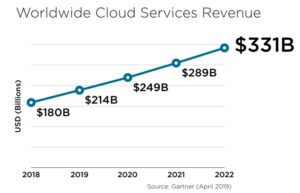
If that was the revenue of just one business by itself, it would still be the fourth or fifth biggest business on the planet. There is real substance here, Yes, this term cloud can sometimes seem vague or ambiguous, so let’s deal with that.
Is cloud a technology buzzword with a lot of hype? Yes, it is, but there’s good reason for all that hype. Not just one good reason but many. But to get a little deeper into those reasons, the benefits of cloud, and even the risks and challenges of it, we need to get clear on some terminology, some jargon.
1.1.1 Types of Cloud Computing
In this cloud computing basics pdf, there are basically two ways to categorize cloud computing as it is ever growing: Cloud Deployments and Cloud Services. These are further divided as shown in Fig 1.1.3.
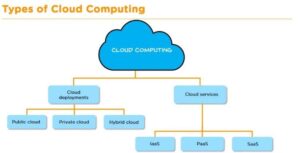
Some different phrases and acronyms we can’t avoid Cloud Computing Basics PDF are…
- Software as a service
- Infrastructure as a service
- Platform as a service
- Virtualization
- Multitenancy
…and so much more!
We’ll talk about how clouds can be deployed, mainly by public clouds, private clouds, hybrid clouds. We will also examine the risks of cloud computing and lots more. We’ll cover the current marketplace and see a lot of the different companies offering cloud services. We will also cover how to recognize and understand what it is these companies actually provide.
But we need to begin at the beginning. What exactly do we mean when we say the cloud or cloud computing? Can we even be exact about those terms? Cloud computing can be defined in various ways. For example, according to Wikipedia…
“Cloud computing is the on-demand availability of computer system resources, especially data storage and computing power, without direct active management by the user”.
Another way it’s described is…
Cloud computing is a computing service you traditional did local (on-premises), now performed remotely, across the internet (off-premises).
Some might put it simply as…
Cloud computing is on-demand computing resources, delivered to you over the internet.
However, this cloud computing basics pdf will be more than just defining and understanding a few pieces of technical jargon. I want to take you far beyond that, so you can actually feel comfortable with cloud computing, feel fluent when you’re talking about it and even get some hands-on experience.
This will help you to intentionally widen how you think about it. Here’s what I mean by that. As we go through it, I’ll ask you to consider cloud computing from a personal (individual) perspective. How could you just yourself get more out of this? What are the products and tools? What are the ways of thinking?
But then we’ll widen that perspective and think about how this could apply to your team because that will be different. We’ll then widen that perspective and think about your organization, their different roles and what they’d want. Then we will be able to push that viewpoint outwards to think about how this could solve issues for your clients or customers.

It’s from doing this, from combining some technical understanding with an intentional awareness of the different audiences, their reasons and their motivation can we get a real sense of what cloud computing is, why it’s become so important over the last few years and how you could use it in different situations. It’s only from doing this that you will be convinced there is a cloud and it is much more than just someone else’s computer.
1.2. A few Reasons for Using Cloud Computing in the Cloud Computing Basics PDF
When I first started teaching about cloud computing, I realized one of my big challenges is I’d go over one or two examples. My students would often be just a little bit too quick to say, okay, I’m good, I got it. I understand now.
That can be an issue because, unlike some technologies, cloud computing is not something that can be explained well with just one or two examples. In fact, that’s a very good way to get the wrong impression about it. But let me unpack that statement because, let’s face it, usually when you want to know more about a technology, it is pretty helpful to just go over one or two examples.
So, you might wonder, why do I say that’s not the right way here? Well, good question dear reader. Let’s imagine I’ve gathered four volunteers together, four people who’ve told me they’re already well-informed about cloud computing and work with it every single day and they’re in different roles. Fig. 1.2.1.
I have a student, an IT professional, a software developer and a chief information officer. Then I ask them to explain cloud computing to me, assuming I know nothing about this, and to just give me a simple explanation in a few words the main benefit of it. What do they use it for?

The student says…
“Well, I use the cloud to back up all my stuff. So, my documents, photos and videos are all safe and I’ll get them anywhere I need them. Oh, and, I use it for streaming music and movies too. That’s a cloud thing.”
The IT professional says…
“Since we moved to the cloud, it’s so much quicker to push out new applications. We don’t have to spend as much time on updates and maintenance, and it’s so easy to scale the systems up when things get busy.”
The software developer says…
“We’re using the cloud as a machine learning and data mining platform. It’s been great. We just didn’t have the capability to do any of this before.”
And the CIO says…
“Cloud computing is a strategic focus for us. We’ve reduced expenses by outsourcing IT functions and we’ve improved cashflow.”
Now, if I was indeed completely new to this, I’d be entitled to say you people are useless! I asked for a simple description but you all described totally different unrelated things. There’s no crossover at all in anything you talked about.
But now imagine if my introduction to this had been just from one of the things these people said. I might think I understood it, but I’d actually have a very narrow and limited understanding. This is a key idea as you get started. The reasons for using cloud computing, the use cases, the benefits, and even the risks and challenges can be incredibly different between individuals and across teams and organizations.
This is why many people find this technology a bit tricky to understand it first. It can seem vague and really hard to define because we’re human. We want a straightforward explanation. The cloud is for doing this thing or the cloud is for doing that thing. But it evades that kind of simple description.
Anyone who says it can be explained with just one basic sentence is giving you a limited view of it. But even if we can’t describe it in just a few words, that doesn’t mean we have to go to the other extreme and say,
“Oh, you can’t even define the cloud. It’s so loose and nebulous. It means anything.”
Now we can get to a better idea about this, the general reasons that anybody finds this useful, by taking a few of those examples (those four scenarios), but then asking a couple of additional but simple questions like, couldn’t you do that already? Let me show you what I mean.
1.3. Different Reasons, Same Benefits
Let’s go back to our hypothetical student. He said his reasons for cloud computing were backup and streaming. Let’s take backup because that’s not some new thing. We’ve talked about backup for decades. So, I might ask him, why do you say you need the cloud for that? I mean, couldn’t you do that already?
He says…
“Well, I mean I used to have to plug my phone into my laptop and then manually copy things across. Sometimes I’d copy that to an external drive in case anything happened and sometimes I just forget. But yeah, I could back up before. The thing is now, if I back up to the cloud, well first I don’t have to do all the manual plugging and unplugging. So, it’s a little faster. I don’t have to be at my desk, I just need an internet connection. So, it’s a bit more convenient. The software on my phone makes it happen automatically in the background so it’s easier. I don’t have to buy and take care of any hardware so it’s cheaper. Oh, and my photos and files aren’t just backed up; they’re also automatically synchronized to all my other devices and that wouldn’t have happened before.”
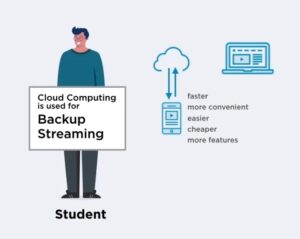
1.3.1 High-Level Benefits of Cloud Computing
What is often described as the reason for using cloud computing, like doing backup, isn’t actually the reason because we could have already done that thing. But the real benefit is when we add cloud computing to the picture, we can often do the same thing but do it easier, faster, cheaper and with a few additional features we didn’t have before.
Of course, this doesn’t just apply to backup. When you explore any specific use case for cloud computing, they will all lead to these same high-level benefits which I’ll describe as cost, convenience, speed and features. Fig 1.3.2.

There is a split here. The first three benefits, cost, convenience and speed can let us recognize that what we’re doing here often isn’t brand new and ground-breaking. We’re dealing with applications, websites, databases and storage. These are all things we might’ve been doing already, either before cloud computing or without cloud computing. But when we add it, those things can become cheaper, easier and/or faster. It is sometimes a little and sometimes much cheaper, easier and/or faster.
But with the fourth benefit (features, which I could have also called capabilities or options), allows us to recognize that adding cloud computing will often enable us to do extra things we simply couldn’t do before, or even if it had been technically possible. That is, things that would have been so cost prohibitive or so time consuming we would never have actually done it.
Now, I’m not pretending that just by adding cloud computing, everything instantly becomes cheaper, easier, faster and more fully featured. No. These four benefits can be prioritized differently. For some organizations, it’s all about the cost of benefits where the only thing they want to get from cloud computing is efficiency, capital expenditure or cash flow.
Now, I’ll admit I dislike it when I hear someone explain cloud computing as nothing but a way to reduce expenses. True. That may be the number one reason for some organizations, it’s not the only reason. Many companies go into it fully expecting it to be an expense because their priority might be in the new capabilities or just being able to reduce time to market. Some examples are shown in Fig 1.3.3.
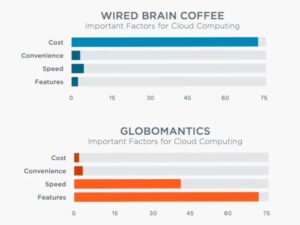
To enjoy the rest of these cloud computing fundamentals, click the button below to continue.


